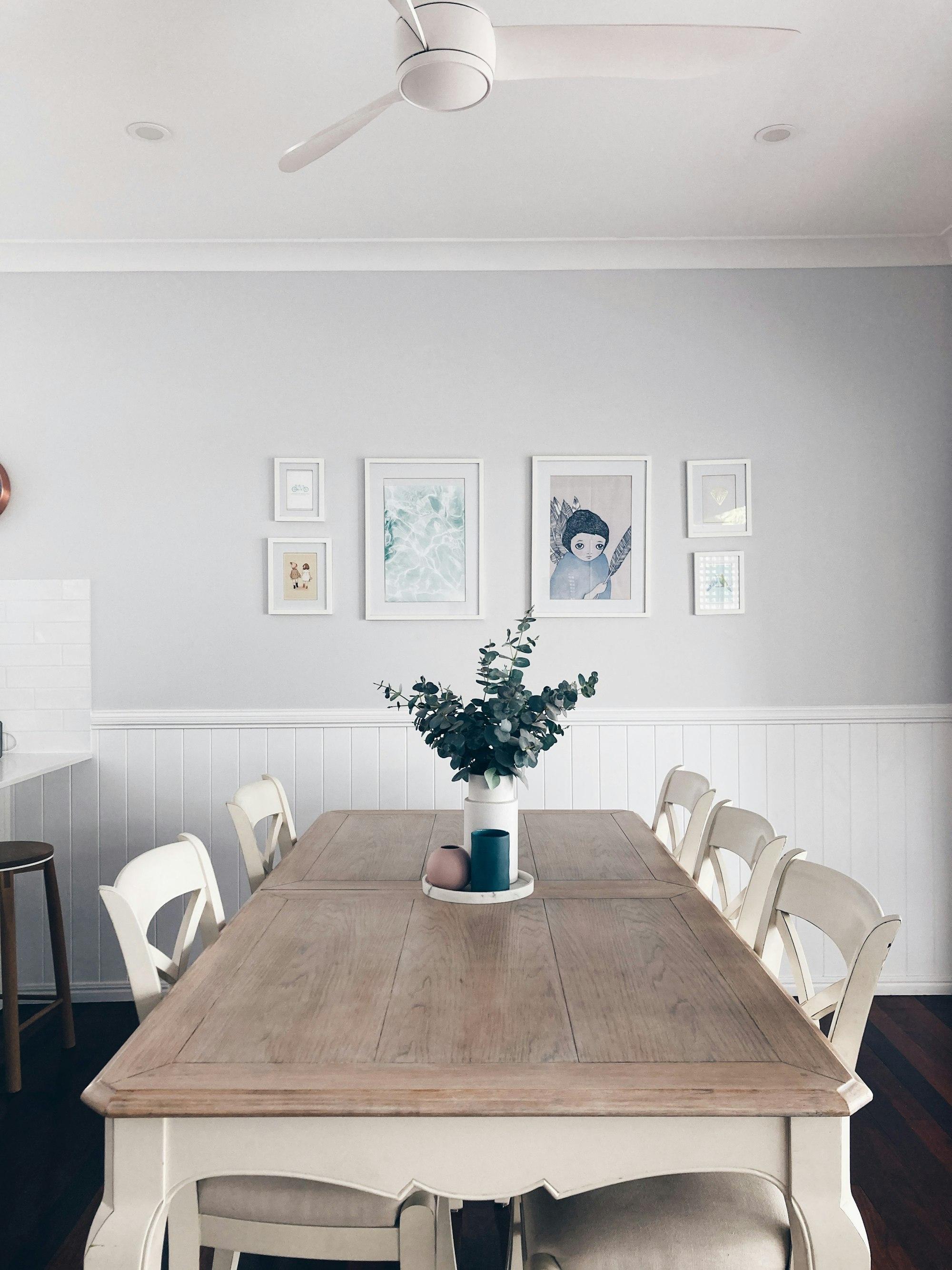What is Wainscoting?
Wall-to-wall elegance: Discover wainscoting, the architectural chameleon that's been dressing up homes for centuries. From raised panels to beadboard, find your perfect match and give your walls a stylish promotion from drab to fab!

Wainscoting, a time-honored architectural feature, has adorned homes for centuries. When I think of wainscoting, I picture homes in the Northeast suburbs or ones being featured on This Old House. But there are actually different types, benefits, and considerations depending on what type of home you have and what kind of aesthetic you're looking to achieve.
The Essence of Wainscoting
Wainscoting is a form of decorative wall treatment applied to the lower portion of interior walls. Traditionally extending from the floor to about waist height, modern applications vary this height based on design preferences. While contemporary wainscoting is primarily aesthetic, it originally served to protect walls from damage and provide additional insulation.
History of Wainscoting
The term "wainscot" derives from the Middle Low German word "wagenschot," referring to high-quality oak boards used for paneling. Wainscoting gained prominence in 16th and 17th century England, adorning the walls of grand homes and public buildings.
Initially, wainscoting provided crucial protection against moisture in an era when damp was a common household enemy. Over time, it evolved into a symbol of craftsmanship and luxury, with intricate designs showcasing both the skill of carpenters and the wealth of homeowners.
As architectural styles changed, wainscoting adapted. From Georgian and Victorian designs to Arts and Crafts and modern minimalism, wainscoting has continually reinvented itself to suit changing tastes.
Types and Styles of Wainscoting
Wainscoting comes in several styles, each offering a distinct aesthetic:
Raised Panel Wainscoting
Raised panel wainscoting features rectangular panels with beveled edges, creating a three-dimensional effect. This style is often associated with formal spaces and classical interiors.
Flat Panel Wainscoting
Flat panel wainscoting consists of recessed panels between vertical stiles. Its clean lines make it versatile for both traditional and contemporary settings.
Beadboard Wainscoting
Characterized by vertical planks with a small bead or indentation between each board, beadboard wainscoting evokes a cottage or coastal aesthetic. It's particularly popular in bathrooms and kitchens.
Board and Batten Wainscoting
This style uses wide boards spaced evenly apart, with narrow strips (battens) covering the seams. It creates a strong vertical emphasis and works well in rustic or farmhouse-inspired interiors.
Overlay Wainscoting
A more modern interpretation, overlay wainscoting involves applying decorative moldings directly onto a flat surface to create patterns. This technique offers flexibility in design and can be adapted to various architectural styles.

Benefits of Wainscoting
Incorporating wainscoting into interior design offers several advantages:
- Visual Interest: Wainscoting adds depth and texture to walls, breaking up large expanses and creating visual interest in otherwise plain rooms.
- Wall Protection: In high-traffic areas, wainscoting can protect walls from scuffs, dents, and general wear, potentially reducing maintenance costs over time.
- Architectural Detail: Wainscoting can enhance the architectural character of a space, adding a sense of craftsmanship and intentionality to the design.
- Versatility: With various styles available, wainscoting can complement a wide range of interior design aesthetics, from traditional to contemporary.
- Proportion and Scale: Strategically placed wainscoting can alter the perceived proportions of a room, potentially making ceilings appear higher or creating a more balanced visual composition.
Installation Considerations
When considering wainscoting, homeowners and designers must weigh the options between professional installation and DIY approaches:
Professional Installation
Advantages:
- Expertise in handling complex designs and irregular room layouts
- Access to specialized tools and materials
- Efficient completion of the project
- Guaranteed quality of workmanship
Considerations:
- Higher upfront costs
- Scheduling and coordination with contractors

DIY Installation
Advantages:
- Potential cost savings on labor
- Personal satisfaction from completing the project
- Flexibility in timing and pace of work
Considerations:
- Requires moderate to advanced carpentry skills
- Time-intensive, especially for novices
- Need for specialized tools and accurate measurements
- Potential for mistakes that may be costly to correct
The choice between professional and DIY installation depends on the project's complexity, the homeowner's skill level, available time, and budget considerations.
Design Principles for Wainscoting
To effectively incorporate wainscoting into an interior space, consider the following design principles:
- Proportion: Generally, wainscoting should occupy one-third of the wall height. However, this can be adjusted based on ceiling height and room function. In rooms with very high ceilings, taller wainscoting can create a more balanced appearance.
- Consistency with Architectural Style: Choose a wainscoting style that complements the overall architectural character of the home. For example, ornate raised panels may be appropriate in a Victorian-style home, while simpler designs might suit a mid-century modern interior.
- Color and Finish: The color of wainscoting can significantly impact the room's ambiance. White wainscoting is a classic choice that can brighten a space and provide contrast. Painting wainscoting the same color as the walls can create a more cohesive, sophisticated look. Consider the finish as well; glossy finishes can add a formal touch, while matte finishes offer a more subdued appearance.
- Integration with Other Elements: Ensure that wainscoting integrates well with other architectural features such as fireplaces, doorways, and windows. The top rail of the wainscoting should align with other horizontal elements in the room for a cohesive look.
- Texture and Material: While wood is the traditional material for wainscoting, modern alternatives include medium-density fiberboard (MDF), polyurethane, and even tile. The choice of material can affect both the aesthetics and practicality of the wainscoting.
Maintenance and Care
Proper maintenance ensures that wainscoting remains an attractive feature for years to come:
- Regular dusting with a soft cloth or vacuum attachment prevents buildup of dirt and debris.
- Periodic cleaning with a mild soap solution and damp cloth can address more stubborn dirt. Avoid harsh chemicals that may damage the finish.
- For painted wainscoting, keep touch-up paint on hand to address minor scratches or chips promptly.
- In areas prone to moisture, such as bathrooms, ensure proper ventilation and address any water damage immediately to prevent warping or mold growth.
- Periodically inspect wainscoting for loose panels, popped nails, or separation at the seams, addressing issues promptly to prevent further damage.
Final Thoughts
Wainscoting offers a blend of functional and aesthetic benefits that can significantly enhance interior spaces. Its versatility allows it to adapt to various architectural styles and personal tastes, while its practical advantages in wall protection and insulation make it a valuable addition to many homes.
When considering wainscoting, careful attention to design principles, installation methods, and ongoing maintenance will ensure that this classic architectural element continues to add value and beauty to interiors for years to come. Whether seeking to add character to a new construction or restore period details in a historic home, wainscoting remains a timeless choice for discerning homeowners and designers.
Check out Spoken and never overpay making your home beautiful.
Quick facts
Why do they call it a wainscot?
Wainscot comes from a Middle Low German word meaning "wall-board," originally describing high-quality oak paneling.
What is the difference between paneling and wainscoting?
Wainscoting covers the lower portion of a wall, while paneling can cover any part of the wall.
What is the golden rule for wainscoting?
Install wainscoting at about one-third the height of the room for balance.
When should you not use wainscoting?
Avoid wainscoting in small or cluttered rooms where it may make the space feel cramped.

Mihai Crisan
Software Engineer at Spoken
Mihai is a dedicated software engineer at Spoken, where he combines his passion for technology with his professional expertise. As a tech geek, he is always on the lookout for innovative solutions to simplify and enhance people's lives through cutting-edge technology. Mihai’s curiosity drives him to explore and implement new ideas that make a real impact.
Read more